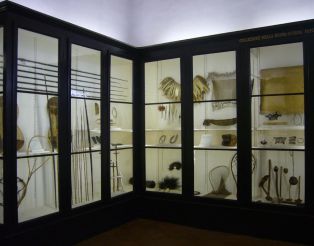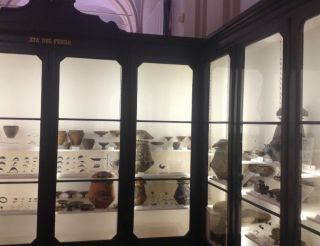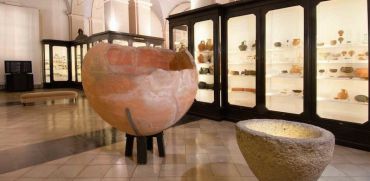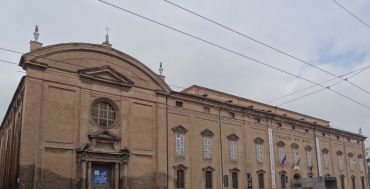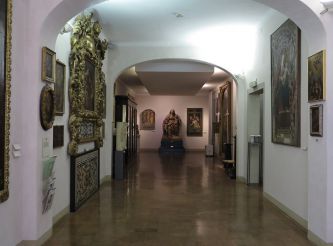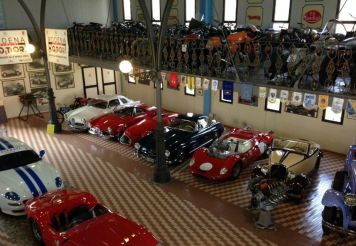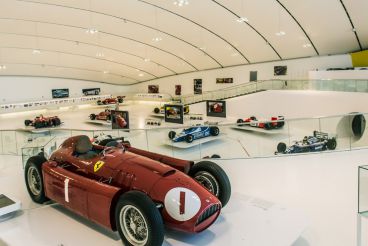Municipal Museum of Archaeology and Ethnology, Modena

Municipal Museum of Archaeology and Ethnology (Museo Archeologico Etnologico) in Modena is part of the network of civilian museums in the city. It is very similar to other city museums in Italy, here much attention is paid to the history of the province. Like many similar institutions, this is a modern interactive museum.
History of the museum
The building, which houses collections of city museums, was built in 1764-1771. Its creation was ordered by the Duke Francesco III d'Este, and it was his family who used the palace for a hundred years. In 1871, after the archaeological excavations, the Modena Civil Museum was founded. And in 10 years, in 1881, the palazzo was redeemed by the city authorities. And in the same year it housed the first exhibition of the newly created museum. Throughout the existence of the institution, its collection was constantly replenished with new exhibits. In 1962 it was divided into 2 parts: the Museum of Archaeology and Ethnology and the Municipal Museum of Art. Despite this, in connection with the agreement reached in the 19th century, the museum route remained holistic.
Exposition of the museum
The museum regularly conducts a program of activities aimed at researching and preserving the heritage, as well as expanding and distributing collections through exhibition, educational and editorial initiatives. The core of the archaeological collection is the materials of the 19-th century excavations, including the discoveries of the scientist Fernando Malavolti, supplemented by items from modern expeditions on the local territory. The exhibition route contains exhibits from the Paleolithic to the Middle Ages, and describes a chronological path that through the evidence of material culture allows you to follow the historical events of the city and the province. It can be divided into several time parts:
- Palaeolithic, Mesolithic and Neolithic. The earliest evidence of the presence of people in the vicinity of Modena is represented here. These are ceramics, stone tools and burial items related to the cultures of Fiorano and Chassey.
- From copper to iron. This period covers the Copper, Bronze and Iron age. The most valuable finds here belong to burials from local settlements known as Terramare emiliane.
- Etruria. In the era of Etruscan settlements on the territory of the Apennines, in the vicinity of modern Modena, there were mainly agricultural lands, villages and necropolises. Excavations of the latter gave a lot of exhibits for the museum's collection.
- Roman period. In this part of the collection there are a lot of items of Roman civilization found on the territory of the city. After all, an ancient Roman city is situated under the modern neighborhoods of Modena, excavations of which are neatly conducted today. The most important finds are items from the necropolis of the ancient city of Mutina: the burial altar Vetilia Egloge of the 1st century, found in 2007, the funeral stele and frieze of the procession of the gods and sea monsters.
- Middle Ages. There are exhibits from the decline of the Roman Empire until the Renaissance. A special emphasis is placed on the presence of the Lombards in the region. The route ends with the old model of the city's Cathedral of Modena.
The ethnological part of the museum began its existence in 1875, and by 1910 was finally consolidated as a separate section. Materials from different civilizations are collected here, both existing and disappeared. The exhibition route retained the original division into geographical areas:
- New Guinea. The hall presents exhibits collected by the scientist Lamberto Loria in 1889-1890 during a trip to the south-western part of the island. Among them there are objects of everyday life, arts, musical and ritual instruments, clothing, weapons and accessories for hunting and fishing.
- Peru before Columbus. Items from the excavations of the late 19th century in the ancient necropolis of the Incas are represented here. These are mainly clothes, textiles and ceramics.
- South America, Africa and Asia. Among the exhibits of this part there are a collection of Indian decorations from the river bed of the Rio Negro River, samurai armor of the 18th century, as well as weapons and a number of other items from the countries of Central Africa where Italy had its colonies.
The museum also has a rich photographic archive, which is currently in the process of reorganization, and a library containing about 6000 volumes. You can take a look at the latter by appointment.
How to get there
The museum is located in the historic center of Modena, on the street Largo Porta S. Agostino, 337. In the same palazzo there is also the Lapidary Museum. Opposite the palace there are bus stops Sant'Agostino Museo (routes 6, 7, 11A) and Ospedale Estense (routes 2, 5, 13).
Opening hours: Tuesday to Friday from 9:00 to 12:00, on Saturday and Sunday – from 10:00 to 13:00 and from 16:00 to 19:00. On weekdays after lunch the museum can be visited after an advance booking in a group of 20 people. Monday is a day off. Phone number: (+39) 059 2033100.
Free admission.



